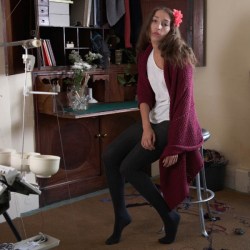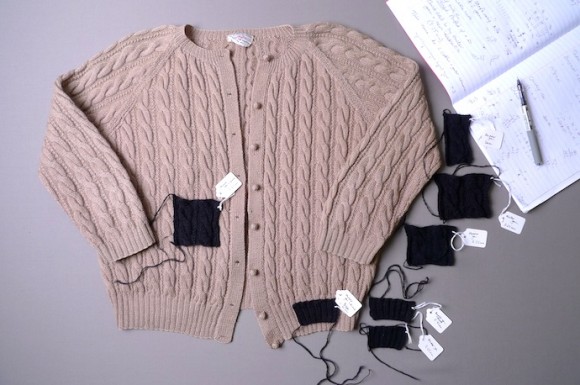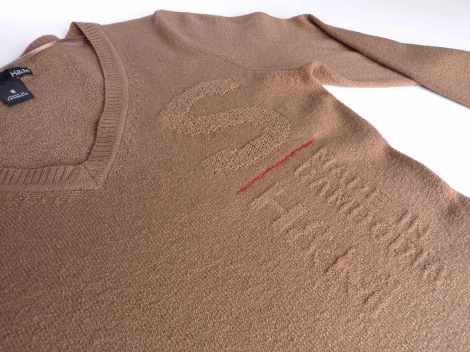
Amy Twigger Holroyd.
Amy Twigger Holroyd approaches fashion with sharing in mind. In one project, she created garments that could be shared by friends with different body types. By making clothes that don’t constrict in places where people vary the most, a size six could potentially share her sweater with a size 16. Yep. Her project basically takes the magic out of Sisterhood of the Traveling Pants. (Unless you count buying a pricey sweater with the express intent of sharing it with friends a different kind of magic, which I certainly do.)
But Holroyd’s projects go beyond one-size-fits-all couture. Her PhD research on “fashion as a commons” is an exploration of how to democratize and disrupt the clothing industry. “If you’re not able to make, you’re dependent on buying,” she says. “And if you’re dependent on buying, you’re dependent on what those people [in the fashion industry] have chosen — the quality of it, the design of it, the aesthetic of it.”
 And so, under the umbrella label Keep & Share, she teaches folks how to fix and knit their own clothing, creates and sells long-lasting, sharable clothing, and hacks into cheap knitwear to send a message about the industry. Thanks to the independence of PhD funding, Holroyd is trying to figure out how to make this work in the real world without, you know, tanking her business in the meantime.
And so, under the umbrella label Keep & Share, she teaches folks how to fix and knit their own clothing, creates and sells long-lasting, sharable clothing, and hacks into cheap knitwear to send a message about the industry. Thanks to the independence of PhD funding, Holroyd is trying to figure out how to make this work in the real world without, you know, tanking her business in the meantime.
Holyroyd has been working and thinking about sustainable fashion since 2003 and describes her job as “designer-maker-researcher — lots of hyphens.” I was curious about Holroyd’s experiments and called her up. Here’s our edited conversation.
Q. I first came across your work with sharable clothing in Fashion and Sustainability. Judging from your website, your work is much broader than that.
A. My design philosophy has always been about trying to help people get more out of each item of clothing, but to do it in a gentle way. There are some approaches like creating clothes to be multifunctional — it’s one thing then it transforms into something else. Whereas, I have always tried to take a more gentle approach. I try to create things that can be shared between purposes. So a garment which you feel comfortable and happy wearing in different situations. And also things that can be worn by different people so they can be handed down over time.

Amy Twigger HolroydCuff in a blanket.
The extreme version of that — in the store, there’s a piece called “Cuff in a blanket.” It’s basically a blanket with one sleeve. The idea is that anybody can wear it. The western ideal of clothing is couture: One garment being made to fit one woman perfectly at one moment in her life. A more eastern approach to clothing is you have a big piece of fabric and you wrap it around you in some way. Therefore the whole concept of fit is completely different. Having a more open approach to fit allows things to be shared much more.
If you want things to be shared, you come up against the assumption that things will go out of fashion and become undesirable. I’ve been exploring how to design garments which are not classic in a classic, boring way, but which retain their interest over time.
Q. You describe your PhD work as “fashion as a commons.” Explain what you mean by that.
A. My research came out of doing workshops — teaching people to knit or teaching them more advanced skills — and the conversations we would have. I felt quite naively that if you could knit, you could suddenly be creative and work outside the fashion system and do your own thing. I found that people were still worrying about what colors were “in” this season. People tried to make things that looked like they came from the shops. …
Over the time of doing my research, I’ve refined my research to exploring the idea of openness. I’m trying to integrate the idea of openness into my existing practice as a fine maker of knitwear. That means opening up my practice and sharing design skills. And in practical terms, the project is about opening up existing garments. Looking at ways of using knitting skills and processes to change existing items of knitwear rather than always making new ones.
Q. You call that “tinkering,” right? I saw an image of an H&M sweater that you had magnified the label of:
A. Yes. Those pieces are more on the arty end, exploring ideas through making objects. We tend to think of manufactured items as closed. I want to see what happens if you try to open them. When I hacked into the H&M sweater, I found myself really thinking about [the fact] that it was made in Cambodia.
I’m looking at changing existing items on two levels. One is upcycling — encouraging people to be able to mend things and repair them and change them, which I think is an important thing to have a more enduring relationship with stuff. But on another level, I’m interested in the conversations it draws out and the thing about changing the thing that is given to you as closed and ready-made by the fashion industry. It does feel quite subversive.
Q. So, why knitting? What does the act of knitting hold that other forms of making clothing don’t?
A. I learned to knit when I was really little, about 5. My grandmother taught me. I’ve studied fashion and I think that I just like the way you can make the fabric and the garments at once. It’s just cool. Within a ball of yarn, you have more potential than you do within a piece of fabric. It’s even more open. Sometimes it can be overwhelming; there’s so much choice in what you do with it. You can make things in three dimensions without seams. It’s clever. I like things that are clever.
Q. I find your projects very interesting as they seem both open source and internet friendly, yet knitting has historical roots as a community activity.
A. It’s interesting thinking about knitting and craft and open source. I firmly think all of those things fit together very well. But it’s hard when there’s lots of small producers who are trying to make their living through craft. You have this kind of tension. Part of what I’m trying to do is work out how to negotiate that tension as a small business, an independent designer. I firmly am quite passionate about the openness and the open source and that kind of thing. And like you say, it has roots in the heritage of craft. It isn’t a privatized, rarefied field.
Q. Just like food, we have an overabundance of cheap and unsatisfying clothing. And, like food, there’s a growing hunger to connect more and know the sources of what we consume. How can taking a more open approach to clothing avoid the good food movement’s biggest issue — namely, being too expensive for most people?
A. Nice yarn is really expensive. It costs so much more to make something than it does to buy it. But when you’re changing an existing item of clothing that you already own and got bored with or it’s got a hole in it, the economic benefit comes right back. You could get a new-to-you item of clothing. Renew the item of clothing without all of the costs of the item. It’s thrifty and sustainable at the same time.
Q. I like your concept of sustainable and satisfying.
A. I think it’s really important. Clothes are so close to your identity and yourself. Individual well-being and satisfaction has to be part of sustainability — not just because otherwise you won’t be able to get people to change, but more fundamentally than that, if we focus on what actually makes you feel satisfied, what meets your fundamental needs, then that probably won’t be loads and loads of stuff. The two will go hand in hand.
Q. You’ve been doing this since 2003. Since then, sustainable clothing has been getting much more press and attention. Do you think sufficiency and sustainability have the ability to shake up or shift the industry in any serious way?
A. No, I don’t think the industry is shifting in any serious way. It’s no surprise because the business model, especially in the U.K., is firmly based on always selling more units, more and more stuff. And so whatever you do, within that, you’re still always working on producing more and more rubbish stuff.
Q. What would your ideal clothing industry look and function like?
A.. It would be a lot more diverse, especially in the U.K. We have a concentration of a few massive companies that retail the majority of clothing. There would be a lot more repair and support for individual people doing their own individual thing. In this country, we turn out thousands and thousands of fashion designers every year. There aren’t any jobs for them. And they tend to have to copy things — it’s how the high street [the fashion industry, in British terms] works. You copy nice designer things and turn them out. There would definitely be a role for designers in supporting amateurs to make their own stuff — so they could benefit from the skills and expertise from trained designers supporting them in making their own choices.
Maybe it’s a fairy tale, but I like the idea of there being a lot more diversity and more localized fashion culture so everywhere doesn’t look the same.




